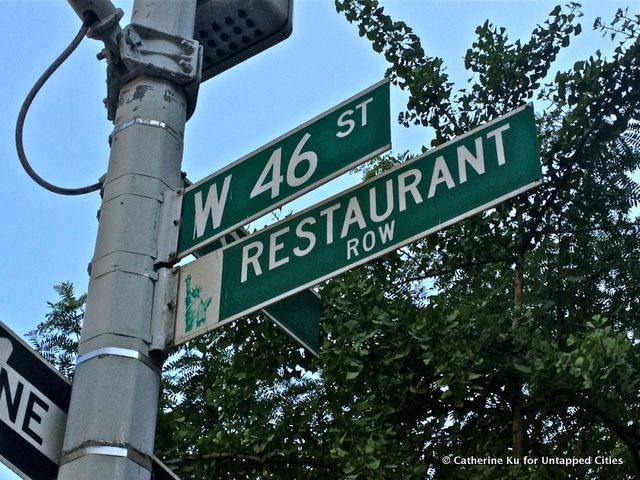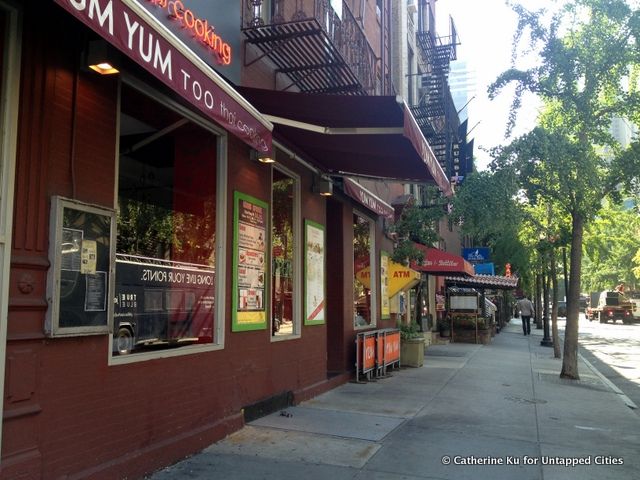Last Chance to Catch NYC's Holiday Notalgia Train
We met the voices of the NYC subway on our nostalgia ride this weekend!



“Where else in the world, except possibly Paris, could you get 16 of the best restaurants collected in such a short strip of land?” At the time of its dedication in 1973, then-Mayor John Lindsay launched Restaurant Row into lofty company with this bold statement. Today, however, the restaurant-lined block of West 46th Street between 8th and 9th Avenues is struggling to live up to Lindsay’s designation as one of the finest concentration of restaurants in the world. While the number of restaurants has expanded to 31, the street’s eateries have been largely overshadowed by the large chains of Times Square and Michelin-starred offerings of Columbus Circle. Nevertheless, the peaceful street lined with brightly colored awnings isn’t going down without a fight. It resisted lawlessness and disorder in the late 1980’s, and as Times Square evolved from taboo to touristy, Restaurant Row is the middle of yet another revival effort.
While the moniker “Restaurant Row” wasn’t made official until 1973, the street has been home to restaurants since the early twentieth century. Its oldest establishment, Barbetta, opened in 1906 and is the Theater District’s oldest restaurant. According to the New York Times, West 46th Street was the perfect location for a few reasons: zoning, location and space. The street is lined with 19th century townhouses, and zoning laws allowed the bottom floors to be used for commercial purposes. With its placement just a few blocks away from Times Square, Restaurant Row is a practical pre-or-post-theater destination.

West 46th Street tends to get overshadowed by the busier 8th and 9th Avenues.
The proximity to Times Square is a double edged sword. In the late eighties and early nineties, drug trade and prostitution thrived in the area–putting off patrons who didn’t want a side of crack or a strip show with dinner. As the Times reported in 1988, “The western corners of Eighth and 46th are one of the principal open-air show places for commercial transvestites in the city.” In 1988, with public faith in the police increasingly shaky, the block’s restaurant owners recruited the Guardian Angels to clean up their neighborhood. This was a citizen patrol that had been formed in 1979, mainly consisting of black and Hispanic teenagers who wore red berets and acted as neighborhood police. The owners provided housing and food for the Angels on Restaurant Row and in return, the Angels helped rid the row of loitering drug dealers, prostitutes and the notorious corner transvestites.
The Angels communicated via walkie talkie and determined punishments based on the severity of the crimes. If they found only a couple vials of crack on a dealer, they would break the vials. Anything larger, and they called the police. They made their headquarters in the old Café de France, and the Restaurant Row owners created a schedule of who would feed the Angels.
More than two decades later, Restaurant Row is in need of another–though slightly less drastic–revival. Times Square may be a huge tourist draw, but food carts and chains like Olive Garden and Bubba Gump keep tourists from straying too far from the main avenues. Recent additions of bike lanes to 8th and 9th Avenues have made pedestrian access to Restaurant Row more difficult.
Last year, the Times Square Alliance planned to install signs and solar-powered lights on the ends of Restaurant Row in hopes of encouraging foot traffic. Illuminated kiosks will be added this fall, and Restaurant Row’s name and slogan “Where the World Comes to Dine” will be painted vintage-style on a building wall. The $150,000 project will be financed by the Manhattan borough president’s office.
The goal is to bring some character to the street and reestablish its identity. Restaurant Row may not have the glamor of Paris or the luxury of Columbus Circle, but as an integral part of Times Square history, it’s certainly worth a visit over Olive Garden.
Subscribe to our newsletter